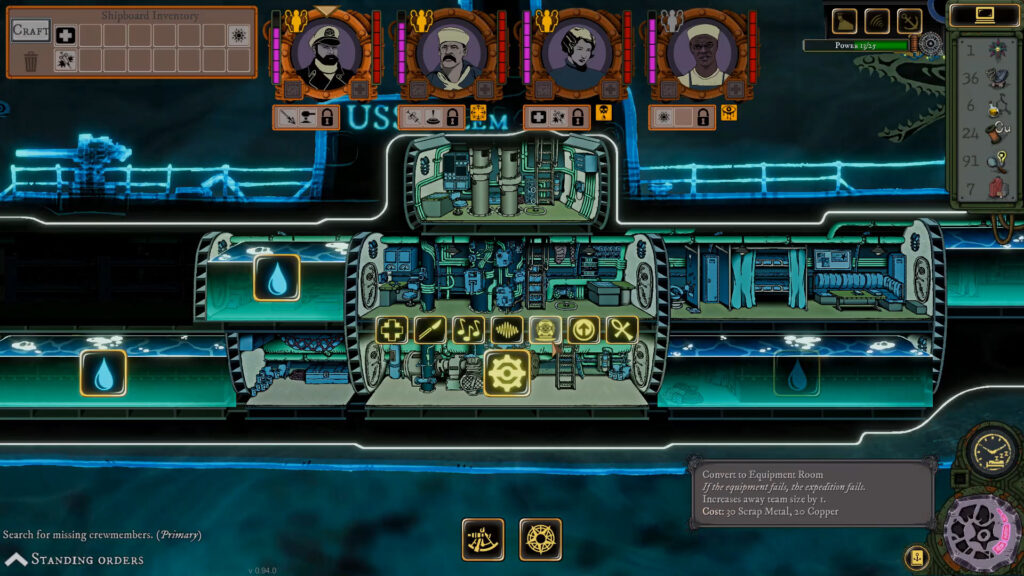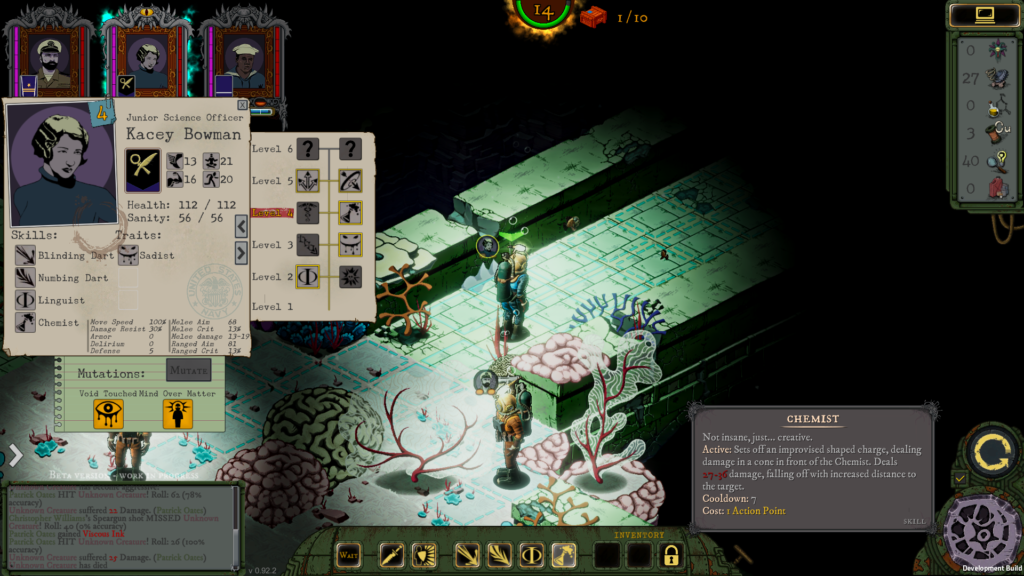It’s hard to overstate the influence of Providence-based writer H.P. Lovecraft. As I mentioned in my review for Call of Cthulhu back in 2018, he was one of the pioneering figures in “weird fiction,” and his stories helped develop a formula that may sound familiar to you. Normal investigators hear of a strange occurrence, they poke around a bit, things get increasingly freaky and they end up encountering some ancient horror from beyond the stars or from the oceans deep that’s lurking around in places like abandoned houses or under cemeteries.
Unlike action and sci-fi stories, these investigators weren’t armed with guns and grenades and military or law enforcement training. They were often frail, bookish types – academics, historians, inexperienced students – which added to the readers’ concern for their safety and heightened the tension.
Often, there were fish people.
On October 29, Slitherine Ltd. released Stirring Abyss, a squad-based tactical RPG by developers Sleepy Sentry and K-Project. And aside from the potential of crushing itself under its own weight, it’s pretty cool. Be patient here, because there’s a lot to cover, but all the different components of the game will affect the game itself and your enjoyment of it.
Based on Lovecraft’s oft-overlooked short story “The Temple,” Stirring Abyss tells the tale of a submarine crew whose unintended journey to the ocean floor leads them to great peril and ancient horrors. I can’t bring myself to spoil “The Temple” for you, but Lovecraft’s work is all in the public domain now and you can read this fantastic short story legally, for free, by clicking right here. For purposes of avoiding spoilers, from this point forward, I’ll speak about the game itself and its overall Lovecraftian elements without mentioning “The Temple” one way or the other.

In the game, your submarine is wrecked by forces unknown and you awaken in a deep-diving suit on the ocean floor. In a brief tutorial mission, you gather up another crew member on the grid-based map and head for the sub, fighting some asshole jellyfish and fish-like people (or human-like fish) along the way. As a squad-based tactical combat RPG, its setup is pretty familiar at first. Isometric view, limited action points per crew member per turn. Moving, attacking, defending, using special skills and so on use up action points; enemies do the same when you’re out of points. Damage and status effects are determined by off-screen dice rolls, characters gain XP and level up – you know the setup. Stick with me though, because it gets crazy.
When your first two crewmen reach the sub, it’s been almost completely flooded. They use the submarine’s remaining power to pump the water from one of the chambers and lurch to their second mission, where they search for more crew members. The sub portion of the game is really interesting though. It gains some energy points back after each mission, which you can use to drain additional flooded chambers – each having different uses for your crew and game – or to cast helpful assists on missions. Assists, by the way, include things like shining a light on an unseen area of the map, which reveals it temporarily.
While you’re in the sub, it looks like a base in X-Com or Fallout: Shelter. The different rooms in the modular, ever-evolving sub do things for you like enabling the healing of crewmates between missions, upgrading things like the crew’s maximum health meters or unlocking the ability to mutate your crew.
Yes, mutate. See, things start off normally enough. As a dive crew whose missions take place out on grid maps on the ocean floor, you have access to several basic weapons: divers’ knives, a harpoon gun, even a dart gun with selectable ammo to apply status effects to monsters. You have to balance an air meter (and keep your crew’s sanity up a la Darkest Dungeon) to stay healthy and effective. When you level up, you gain limited normal skills like Medic, which enables you to heal a percentage of recently-received damage and bandage others’ wounds.
After a couple missions, though, things take a turn for the bizarre. The ship’s crew find artifacts from “the void” strewn about maps that can be used to give each crew member an unnatural power. Are a few sea creatures just a couple of squares away and looking at you like they just caught you in bed with their wives? You can cast a spell (of sorts) on them that does decent damage and makes them explode, damaging nearby enemies. You pick from two options that are rolled at random when you use a void artifact.
While you’re out on missions, you find several kinds of salvageable items – copper, scrap metal, chemicals and so on – as well as clues. Clues, which are found by investigating bodies of new enemy types or rummaging through story-based items, can be redeemed in the sub for those health bar-increasing upgrades and so on. Salvageable items are used to power up the pumped-out chambers and craft usable items and medkits and such.

And still there’s more. Early in the game you meet a formless power that grants you even more weird powers, which you cast by using “Invocation Points” that are limited but refill every mission. These new powers are short-term perks like “When your crew member loses all their sanity points and goes nuttier than a shithouse on a peanut farm, they won’t attack other crew members” (my wording). Additionally, there’s a Corruption Meter that moves up a rank every so often. Each time corruption is increased, enemies get tougher, among other things. This can be counteracted by going on side missions with certain criteria that must be met to ease off the corruption and level out the difficulty.
There are also classic tabletop-like decisions to be made as you inspect certain signs of civilization on the ocean floor. When you find a dead shipmate whose body is in the middle of being ritually sacrificed, but his killer is gone, do you loot the body, bury it or complete the ritual yourself? Consequences await, as does permadeath for your crew members. It is not an easy game.
Quick recap. Stirring Abyss is a squad-based tactical RPG based on Lovecraft’s “The Temple.” You level up your characters and send them into combat – against an ancient civilization of horrific fish monsters – with normal weapons, crafted weapons, natural abilities, unnatural powers, other unnatural powers, an ever-threatening “Corruption Meter” hanging over your head like a vulture, a life meter, an air meter, a sanity meter, choice-based interactions, a sub to repair, sub-based in-mission assists, sub-based perks and leveling perks. And of course, stats for each character.
I can’t score this game based on what you can handle. That’s for you to decide. In my opinion, it was a little much to keep balanced all at once – especially considering it introduces all those elements to you (as well as the game’s story itself) in the first 90 minutes or so of gameplay. But some of it is also pretty boilerplate tabletop stuff, just thrown at you in different ways, so maybe I’m just simple folk.
Having said all that, each mechanic of the game works very well. It’s a lot of plates to keep spinning, without a doubt. But if you’re up for it, the game itself plays as a challenging but rewarding experience. The tension is always there, compounded by keeping your meters up and the Corruption down. Your sub’s power and functionality are always in the back of your mind as well. Time and resources seem fleeting and precious from the first moment to the last. To paraphrase Hippy from James Cameron’s The Abyss, it’s got a Sphincter Factor of about 9.5.

Another high point is the Lovecraft element. Without going into too much detail about the story of “The Temple,” I can say that Stirring Abyss clearly captured everything one would want from seeing its source material digitized without playing it too safe or straying too far from the path. American Literature purists may boo-hoo the game’s frequent tendency of calling attention to the hope, endurance and indomitability of this crew who are Hell-bent on surviving rather than sticking to Lovecraft’s pessimistic and lightless narrative, but all gameplay revolves around having a goal for your efforts. If the game went full-on dismal, what would you have to look forward to for your troubles?
Adding on that, the rest of the game works well with Lovecraft. The horrific ancient aquatic race you encounter feels authentic to his novella The Shadow Over Innsmouth and the malignant artifacts of their culture give players the same feeling as those in “The Call of Cthulhu” (the story, not the game) and other short Lovecraft works. The ever-dimming sanity, the impending doom of something out-of-sight being just on the edge of bursting forth, the unprepared humans discovering something nobody should discover – it all just works. Big ups for the developers working it so successfully into a game with so much combat and action.
In terms of audio, Stirring Abyss is sometimes simple but generally effective. I could’ve used more musical tracks, but the bombastic fight music and creeping exploration tunes were solid overall. The sound effects are good too – nothing award-winning, but they get the job done.
Then there’s the actual graphics. They’re a mixture of gritty comic book style with heavy lines for the character portraits and such (again, think of Darkest Dungeon) and mostly 2-D hand-drawn character models for the creatures and various detritus like seaweed and small rocks populating the levels. However, one bizarre element that sticks out like a sore thumb is the actual player character models while you’re on a mission. I could be wrong, but they look like the developers rendered 3-D characters, captured their animations, flattened them to a 2-D video and cut out around them before putting them in the game. They look like characters from the old Oddworld games or the original Donkey Kong Country and it’s really an odd choice. I wouldn’t say it’s game-breaking but it’s definitely a misstep.
In the end, it’s clear that Sleepy Sentry and K-Project put the myriad gameplay elements first and foremost when it came to Stirring Abyss, with Lovecraft in a close second. It doesn’t always have the sensory polish one would hope for, but if you can manage all of its mechanics, there’s a lot to be found in its depths.
